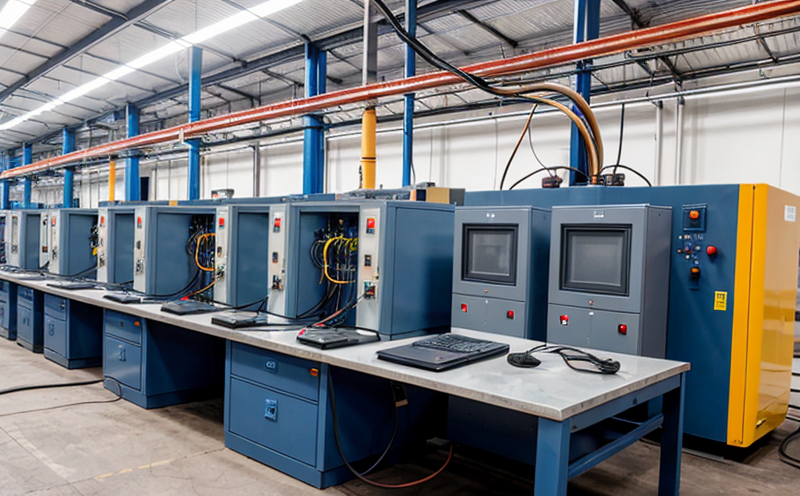IEC 60990 Touch Current Testing of Control Equipment
The International Electrotechnical Commission (IEC) standard IEC 60990 is pivotal for the testing and certification of control equipment, focusing on touch current limits to ensure safety in potentially hazardous environments. This standard applies to electrical devices that may be touched by personnel during normal operation or maintenance. The primary objective is to prevent electric shock hazards by limiting the amount of current that can flow through a person if they accidentally come into contact with exposed live parts.
The testing procedure involves applying specified test voltages and measuring the resulting touch currents. This ensures compliance with IEC 60990, which sets specific limits on touch current values for various categories of equipment. The standard is particularly relevant in industrial manufacturing settings where machinery and control systems are frequently operated by personnel.
The process begins with thorough preparation of the test specimen, ensuring that it represents real-world conditions as closely as possible. This includes verifying that all parts intended to be touched during operation or maintenance are exposed. The testing apparatus used must meet stringent accuracy requirements specified in IEC standards to ensure reliable and repeatable results.
Once the equipment is prepared, the test voltage is applied according to the prescribed limits for the specific category of control equipment being tested. This step is critical as it simulates the conditions under which a person might come into contact with the live parts. The touch current is then measured using appropriate instrumentation, and the results are compared against the permissible values defined in IEC 60990.
The acceptance criteria for passing this test are based on the maximum allowable touch currents for each category of equipment. If the measured touch current exceeds these limits, the equipment fails the test and must be modified or re-engineered to meet the specified requirements. Compliance with IEC 60990 is mandatory in many jurisdictions where industrial electrical control systems are used.
Compliance testing under IEC 60990 ensures that control equipment meets the highest safety standards, protecting personnel and minimizing the risk of accidents. This standard plays a crucial role in safeguarding workers in hazardous environments, such as chemical plants, mining operations, and power generation facilities.
Why It Matters
The importance of IEC 60990 touch current testing cannot be overstated. In industrial settings, electrical control systems are integral to the operation and safety of complex machinery and processes. Ensuring that these systems comply with IEC 60990 is essential for several reasons:
Prevents electric shock hazards: By limiting touch currents, this testing ensures that even accidental contact with exposed live parts does not result in dangerous levels of current flow.
Enhances worker safety: Compliance with IEC 60990 significantly reduces the risk of injury or death due to electrical accidents in hazardous environments.
Maintains regulatory compliance: Many industries are subject to stringent regulations requiring proof of compliance with international standards like IEC 60990. Failure to comply can result in fines, operational disruptions, and reputational damage.
Improves product quality: Testing under IEC 60990 ensures that control equipment meets the highest safety standards, enhancing overall product reliability and performance.
In summary, IEC 60990 touch current testing is a critical step in ensuring the safe operation of industrial electrical systems. It contributes to worker safety, regulatory compliance, and improved product quality, making it an indispensable part of any comprehensive quality management system.
Customer Impact and Satisfaction
Compliance with IEC 60990 touch current testing not only enhances safety but also has a positive impact on customer satisfaction in several ways:
Increased confidence in products: Customers are more likely to trust industrial control equipment that complies with recognized international standards, leading to higher levels of confidence and loyalty.
Reduced liability risks: By ensuring compliance with IEC 60990, manufacturers can significantly reduce the risk of legal action resulting from accidents or injuries caused by non-compliant equipment.
Enhanced reputation: Companies that demonstrate a commitment to safety and quality through rigorous testing are more likely to build a positive brand reputation, which can attract new customers and retain existing ones.
Competitive advantage: Meeting or exceeding international standards like IEC 60990 positions companies as industry leaders in terms of safety and reliability, giving them a competitive edge over competitors who may not meet these stringent requirements.
In conclusion, the impact of IEC 60990 touch current testing extends beyond mere compliance; it significantly enhances customer satisfaction by fostering trust, reducing risk, and positioning companies as leaders in their industry.
Use Cases and Application Examples
Mining Operations: In underground mines where electrical equipment is frequently accessed by personnel, IEC 60990 testing ensures that control systems are safe to touch even during maintenance.
Petrochemical Plants: Compliant industrial control systems prevent accidents in environments with high levels of flammable materials.
Power Generation Facilities: Ensuring compliance helps maintain the integrity and safety of large-scale electrical infrastructure.
Automotive Factories: Touch current testing is crucial for safeguarding workers in environments where rapid assembly lines require frequent human interaction.
Pharmaceutical Manufacturing: Compliance with IEC 60990 helps prevent accidents that could compromise product quality and safety.
In each of these industries, the application of IEC 60990 ensures that industrial electrical control systems are safe for personnel to operate or maintain. This testing is a critical component of overall risk management strategies in hazardous environments.





